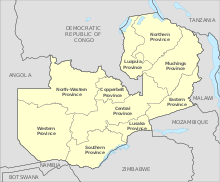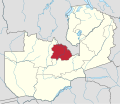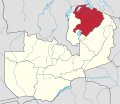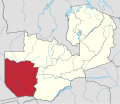Provinces of Zambia
| Provinces of Zambia | |
|---|---|
 | |
| Category | Unitary state |
| Location | Zambia |
| Created |
|
| Number | 10 Provinces |
| Populations | 872,146 (Western Province) – 3,476,384 (Lusaka Province) |
| Areas | 2,125 km2 (820 sq mi) (Lusaka Province) – 126,386 km2 (48,798 sq mi) (Western Province) |
| Government | |
| Subdivisions | |
 |
|---|
|
|
Zambia is divided into ten provinces.[1] The provinces are further subdivided into districts. The Provincial Administration is headed by a Provincial Minister, who is appointed by the President, and is responsible for overseeing the implementation of government policies and coordinating the activities of various government departments within the province. The Provincial Minister is supported by a Provincial Permanent Secretary, who handles the day-to-day administration. Each province has a Provincial Development Coordinating Committee (PDCC) that plays a key role in development planning and coordinating projects within the province.
The current provinces were established following Zambia's independence in 1964, although their borders and functions have evolved over time to support the country’s decentralization efforts.
List of provinces
[edit]| Province[2] | Capital | Area (km2) | Population (2022) | Density (people/km2) |
Districts | Map |
|---|---|---|---|---|---|---|
| Central[3] | Kabwe | 110,450 | 2,422,000 | 21.9 | 11 |  |
| Copperbelt[4] | Ndola | 31,328 | 2,823,000 | 90.2 | 10 |  |
| Eastern | Chipata | 98,877 | 2,603,000 | 26.3 | 15 |  |
| Luapula | Mansa | 50,567 | 1,535,000 | 30.4 | 12 |  |
| Lusaka[3] | Lusaka | 23,490 | 3,287,000 | 140.0 | 6 |  |
| Muchinga[5] | Chinsali[6] | 70,405 | 926,000 | 13.2 | 8 |  |
| North-Western | Solwezi | 125,826 | 1,350,000 | 10.7 | 11 |  |
| Northern | Kasama | 77,650 | 1,743,000 | 22.4 | 12 |  |
| Southern | Choma | 68,410 | 2,455,000 | 35.8 | 15 |  |
| Western[4] | Mongu | 126,386 | 1,378,000 | 10.9 | 16 |  |
| Zambia | Lusaka | 752,612 | 19,614,000 | 26.1 | 116 |
Administration
[edit]The provincial government in Zambia is primarily established for administrative purposes. Each province is headed by a Provincial Minister appointed by the President, who oversees the implementation of national policies and government programs at the provincial level. The administrative head of each province is the Provincial Permanent Secretary, also appointed by the President, who is responsible for the day-to-day administration of the province. Supporting the Permanent Secretary are the Deputy Permanent Secretary, heads of government departments, and other civil servants at the provincial level.
Provinces are further divided into districts, with 116 districts across the 10 provinces. Each district (except for Mafinga and Kanchibiya) shares its name with its headquarters. Within each district, there is a council headed by an elected representative known as a Councilor. Councilors hold office for five years and play a key role in local governance.
The administrative staff of the council is selected by the Local Government Service Commission, either from within or outside the district. The office of the provincial government is located in each district headquarters and includes provincial local government officers and auditors.
Each council is responsible for raising and collecting local taxes. These funds are crucial for the council's operations, which include maintaining infrastructure and delivering services. The council's budget is audited annually and submitted to the central government for review. Councilors do not receive salaries but are compensated with allowances funded by the council.
Zambia’s provinces are predominantly rural, with only five city councils, namely Lusaka, Ndola, Kitwe, Livingstone and Chipata. The Zambian government has outlined 63 different functions for the councils, focusing mainly on infrastructure management and local administration. These functions include maintaining community centers, parks, drainage systems, playgrounds, cemeteries, libraries, museums, and art galleries.
In addition to these responsibilities, councils collaborate with specific government departments to support agriculture, natural resource conservation, postal services, and the establishment and maintenance of hospitals, schools, and colleges. The councils also prepare schemes to encourage community participation and development at the local level.[7][8]
Primary data
[edit]Western Province is the largest in terms of area, having 126,386 km2, while Lusaka was the smallest with 21,896 km2. In terms of population, Lusaka is the most populated and most densely populated with a population of 2,191,225 and densf 100 persons per km2. As of 2010, Western Province had the best sex ratio of 108 females for every 100 males, while Copperbelt had the lowest of 101. Northern had the highest number of basic schools, while Copperbelt had the highest number of high schools. The unemployment rate of youth (55%) and general unemployment rate (32%) was the highest in Copperbelt province, while Eastern had the lowest unemployment rate of 6 per cent. AIDS death was maximum in Copperbelt with 26,799 recorded deaths in 2010, while it was lowest in North-Western with 2,859 recorded deaths. Lusaka Province had the most doctors and fewest malaria related incidents, while North-Western has the lowest number of doctors.[9][10][11][12][13][14][15][16][17][18]
| Parameter | Year | Central[9] | Copperbelt[13] | Eastern[17] | Luapula[10] | Lusaka[14] | Muchinga Province[11] | Northern[18] | North-Western[15] | Southern[12] | Western[16] |
|---|---|---|---|---|---|---|---|---|---|---|---|
| Capital | Kabwe | Ndola | Chipata | Mansa | Lusaka | Chinsali | Kasama | Solwezi | Choma | Mongu | |
| Provincial Minister | 2022 | Hon. Mwabashike Nkulukusa[19] | Hon. Elisha Matambo[19] | Hon. Peter Phiri[19] | Hon. Derricky Chilundika | Hon. Sheal Mulyata[19] | Hon. Henry Sikazwe[19] | Hon. Leonard Mbao[19] | Hon. Robert Lihefu[19] | Hon. Credo Nanjuwa[19] | Hon. Kapelwa Mbangweta[19] |
| Land area, km2 | 94,394 | 31,328 | 51,476 | 50,567 | 21,896 | 87,806 | 77,650 | 125,826 | 85,283 | 126,386 | |
| Population, persons | 2010 | 1,307,111 | 1,972,317 | 1,592,661 | 991,927 | 2,191,225 | 711,657 | 1,105,824 | 727,044 | 1,589,926 | 902,974 |
| Population density, people per km2 | 2010 | 14 | 63 | 31 | 20 | 100 | 8 | 14 | 6 | 19 | 7 |
| Sex Ratio (females per 100 males) | 2010 | 102 | 101 | 103 | 103 | 102 | 103 | 102 | 103 | 104 | 108 |
| Basic Schools | 2004 | 653 | 856 | 861 | 527 | 502 | No data | 1,208 | 536 | 995 | 648 |
| High Schools | 2004 | 28 | 71 | 41 | 20 | 39 | No data | 26 | 23 | 45 | 26 |
| Out of School Children Aged 7–15 | 2004 | 33,081 | 14,332 | 132,728 | 58,887 | 90,620 | No data | 22,348 | 26,834 | 30,390 | 36,984 |
| Unemployment rate (%) | 2008 | 9 | 32 | 6 | 6 | 31 | No data | 7 | 14 | 7 | 10 |
| Unemployment rate, Youth (%) | 2008 | 18 | 55 | 12 | 14 | 52 | No data | 012 | 31 | 6 | 18 |
| Doctors | 2005 | 035 | 213 | 36 | 30 | 231 | No data | 40 | 25 | 50 | 46 |
| Malaria Incidence rate per 1,000 population | 2005 | 331 | 377 | 447 | 407 | 313 | No data | 331 | 439 | 344 | 430 |
| AIDS Deaths | 2010 | 9,016 | 26,799 | 9,338 | 5,209 | 15,429 | No data | 6,958 | 2,859 | 12,403 | 6,044 |
Economy
[edit]Agriculture is the major profession in most of the provinces in Zambia. Maize, mixed beans, rice, sorghum, soya beans, sunflower, sweet potatoes and wheat are the major crops in the provinces. Among all provinces, Central had the maximum area, 391,593.23 ha (967,647.9 acres), constituting 20.64 per cent of the total, while Luapula had the smallest area at 3.06 per cent. Maize production was maximum in Eastern (22.5%), mixed beans (51.66%) in Northern, sorghum in Southern (40.62%), sunflower in Eastern (70.2%), soya beans (45.06%), sweet potatoes (28.5%) and wheat (49.51%) in Central Province.[20]
| Paramaeter | Central | Copperbelt | Eastern | Luapula | Lusaka | Muchinga Province | Northern | North-Western | Southern | Western |
|---|---|---|---|---|---|---|---|---|---|---|
| Area Planted (HA) | 391,593.23 | 122,525.52 | 387,273.09 | 57,966.31 | 82,603.72 | 112,345.23 | 191,104.56 | 79,528.80 | 360,160.32 | 112,153.47 |
| Maize Production | 723,760.85 | 235,415.71 | 745,580.30 | 131,746.91 | 148,290.62 | 244,978.50 | 283,755.88 | 160,866.33 | 597,999.41 | 78,276.86 |
| Mixed Beans Production | 5,316.43 | 1,213.88 | 2,794.77 | 4,130.48 | 673.80 | 9,277.33 | 31,898.08 | 4,446.71 | 1,685.30 | 312.13 |
| Rice Production | 017.85 | 004.24 | 900.37 | 2,254.43 | 036.53 | 6,928.63 | 18,169.24 | 445.61 | 021.22 | 20,861.51 |
| Sorghum Production | 452.85 | 587.45 | 200.49 | 105.83 | 320.21 | 3,118.55 | 283.55 | 1,038.13 | 4,694.90 | 755.44 |
| Soya Beans Production | 96,518.03 | 37,609.86 | 17,534.11 | 430.00 | 32,237.44 | 2,245.70 | 4,742.11 | 579.67 | 22,203.88 | 077.92 |
| Sun Flower Production | 2,872.09 | 028.67 | 24,053.17 | 005.58 | 049.21 | 432.17 | 764.17 | 014.86 | 6,042.08 | 001.66 |
| Sweet Potatoes Production | 42,787.85 | 11,603.63 | 7,842.74 | 11,356.02 | 4,689.72 | 18,151.34 | 11,636.01 | 8,200.76 | 31,048.67 | 2,841.24 |
| Wheat Production | 99,758.27 | 28,690.00 | 120.00 | 000.00 | 48,509.73 | 000.00 | 000.00 | 000.00 | 24,426.13 | 000.00 |
| Grand Total | 971,484.23 | 315,153.44 | 799,025.94 | 150,029.26 | 234,807.26 | 285,132.23 | 351,249.04 | 175,592.09 | 688,121.60 | 103,126.75 |
| Central | Copperbelt | Eastern | Luapula | Lusaka | Muchinga | Northern | North-Western | Southern | Western | Total | |
|---|---|---|---|---|---|---|---|---|---|---|---|
| Area Harvested | 266,864 | 109,399 | 272,019 | 67,117 | 66,765 | 84,533 | 152,028 | 77,014 | 235,349 | 87,282 | 1,418,370 |
| Production (MT) | 681,913 | 317,771 | 544,303 | 174,106 | 138,395 | 258,318 | 376,133 | 225,296 | 448,479 | 96,971 | 3,261,685 |
| Percentage Contribution | 21% | 10% | 17% | 5% | 4% | 8% | 12% | 7% | 14% | 3% | 100% |
| Yield (MT/Ha) | 2.6 | 2.9 | 2.0 | 2.6 | 2.1 | 3.0 | 2.5 | 2.9 | 1.9 | 1.1 | 2.3 |
Human Development
[edit]This is a list of 9 provinces by Human Development Index as of 2017.[22]
| Medium Human Development | ||
|---|---|---|
| Rank | Province | 2017 HDI |
| 1 | Lusaka | 0.672 |
| 2 | Copperbelt | 0.670 |
| 3 | Southern | 0.590 |
| - | 0.589 | |
| 4 | Central | 0.572 |
| 5 | North-Western | 0.564 |
| Low Human Development | ||
| 6 | Northern | 0.538 |
| 7 | Western | 0.531 |
| 8 | Luapula | 0.528 |
| 9 | Eastern | 0.507 |
See also
[edit]References
[edit]- ^ "Provinces of Zambia - Government of Zambia". Government of Zambia. 1 September 2023. Retrieved 2 September 2024.
- ^ Gwillim Law. "Zambia Provinces". Retrieved 18 June 2015. (Population figures are from the census of 2022).
- ^ a b Lusaka province was split from Central province in 1973. Initially Lusaka province was only 360 km2, but by 1988 it had been enlarged to its present size.
- ^ a b The Copperbelt province was known as Western Province until 1969. At the same time the name of the Barotseland province was changed to Western province.
- ^ Created in November 2011, consisting of 5 districts from Northern Province and one from Eastern.
- ^ Zambia's 10th Province, Muchinga, Ministry of Local Government and Housing, Zambia Archived 2014-01-18 at the Wayback Machine
- ^ Zambia Public Administration Country Profile (PDF) (Report). Division for Public Administration and Development Management (DPADM), Department of Economic and Social Affairs (DESA), United Nations. 2004. p. 7. Retrieved 16 October 2016.
- ^ The local government system in Zambia (PDF) (Report). Commonwealth Local Government Forum. pp. 218–220. Retrieved 16 October 2016.
- ^ a b "Primary Data of Central Province". Zambia data portal, Central statistical Office of Zambia. 2011. Retrieved 16 October 2016.
- ^ a b "Primary Data of Lauapula Province". Zambia data portal, Central statistical Office of Zambia. 2011. Retrieved 16 October 2016.
- ^ a b "Primary Data of Muchinga Province". Zambia data portal, Central statistical Office of Zambia. 2011. Retrieved 16 October 2016.
- ^ a b "Primary Data of Southern Province". Zambia data portal, Central statistical Office of Zambia. 2011. Retrieved 16 October 2016.
- ^ a b "Primary Data of Copperbelt Province". Zambia data portal, Central statistical Office of Zambia. 2011. Retrieved 16 October 2016.
- ^ a b "Primary Data of Lusaka Province". Zambia data portal, Central statistical Office of Zambia. 2011. Retrieved 16 October 2016.
- ^ a b "Primary Data of North-Western Province". Zambia data portal, Central statistical Office of Zambia. 2011. Retrieved 16 October 2016.
- ^ a b "Primary Data of Western Province". Zambia data portal, Central statistical Office of Zambia. 2011. Retrieved 16 October 2016.
- ^ a b "Primary Data of Eastern Province". Zambia data portal, Central statistical Office of Zambia. 2011. Retrieved 16 October 2016.
- ^ a b "Primary Data of Northern Province". Zambia data portal, Central statistical Office of Zambia. 2011. Retrieved 16 October 2016.
- ^ a b c d e f g h i "Provincial Ministers | National Assembly of Zambia". www.parliament.gov.zm. Retrieved 29 August 2022.
- ^ a b "Agriculture statistics of Zambia 2014". Central Statistical Office of Zambia. 2016. Retrieved 17 October 2016.
- ^ "Zambia Maintains its Status as a Net Exporter of Corn" (PDF). apps.fas.usda.gov. 13 July 2023. Retrieved 28 August 2023.
- ^ "Sub-national HDI – Area Database – Global Data Lab". hdi.globaldatalab.org. Retrieved 13 September 2018.
